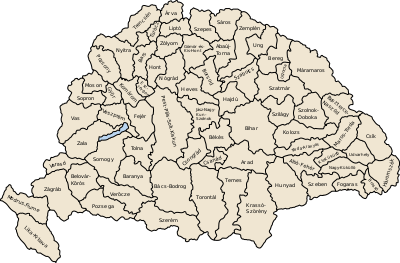Szatmár County
Szatmár County (Hungarian: Szatmár vármegye [ˈsɒtmaːr ˈvaːrmɛɟɛ]) was an administrative county (comitatus) of the Kingdom of Hungary, situated south of the river Tisza. Most of its territory is now divided between Romania and Hungary, while a very small area is part of Ukraine. The capital of the county was Nagykároly, today called Carei (in Romanian).
| Szatmár County | |
|---|---|
| County of the Kingdom of Hungary (11th century-1923, 1938-1945) | |
 Coat of arms
| |
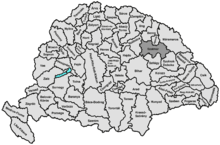 Szatmár county between 1876 and 1920 | |
| Capital | Nagykároly; Mátészalka (1920-1923) |
| Area | |
| • Coordinates | 47°41′N 22°28′E |
• 1910 | 6,287 km2 (2,427 sq mi) |
| Population | |
• 1910 | 396632 |
| History | |
• Established | 11th century |
• Treaty of Trianon | 4 June 1920 |
• Merged into Szatmár-Ugocsa-Bereg County | 1923 |
• County recreated (First Vienna Award) | 2 November 1938 |
• Merged into Szatmár-Bereg County | 1945 |
| Today part of | (4,505 km2)
(~0,4 km2) |
| Carei is the current name of the capital. | |
Geography
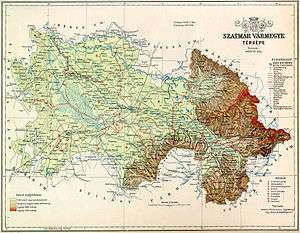
After 1876 Szatmár county shared borders with the former Hungarian counties Szabolcs, Bereg, Ugocsa, Máramaros, Szolnok-Doboka, Szilágy and Bihar. It was situated south of the river Tisza. The river Szamos flowed through the county. Its area was 6257 km² around 1910.
History
In 1920 the Treaty of Trianon assigned most of the territory of the county to Romania, while the village of Nagypalád (now Velika Palad') was passed to Czechoslovakia in 1921 after border adjustment agreement with Romania. According to the agreement also Akli (now Okli) and Fertősalmás (it was known as Ferkeš-Almaš in Romania and Czechoslovakia, now Fertesolmas) villages were passed to Czechoslovakia; whereas Bocskó (Bočkov in Czech, now Bocicău), Ugocsakomlós (Komlóš in Czech, now Comlăușa), Avaspatak (Suchý Potok in Czech, now Valea Seacă), Nagytarna (Veľkú Terna in Czech, now Tarna Mare) ones and several municipalities in were passed to Romania.[1]
The northwest of the county remained in Hungary, and formed the new county Szatmár-Ugocsa-Bereg in 1923 with parts of the former Bereg and Ugocsa counties. The capital of this county was Mátészalka, which was previously in Szatmár county. By the First Vienna Award, Nagypalád was returned to Hungary and the county was recreated and later expanded with the Romanian part by the Second Vienna Award in 1940. After the end of World War II this part became again part of Romania and Nagypalád were passed to the Soviet Union, while the remaining territory in Hungary was renamed to Szatmár-Bereg county.
In 1950, Szatmár-Bereg County was merged with large parts of Szabolcs county to form Szabolcs-Szatmár county. This county was renamed Szabolcs-Szatmár-Bereg in the 1990s.
The Romanian part of the county is now part of the Romanian county Satu Mare, except the easternmost part (including Baia Mare), which is in Maramureş county.
Demographics
In 1900, the county had a population of 367,570 people and was composed of the following linguistic communities:[2]
- Hungarian: 235,015 (63.9%)
- Romanian: 118,770 (32.3%)
- German: 11,763 (3.2%)
- Slovak: 449 (0.1%)
- Ruthenian: 279 (0.0%)
- Croatian: 246 (0.0%)
- Serbian: 20 (0.0%)
- Other or unknown: 1,028 (0.3%)
According to the census of 1900, the county was composed of the following religious communities:[3]
- Greek Catholic: 156,063 (42.5%)
- Calvinist: 118,866 (32.3%)
- Roman Catholic: 62,803 (17.1%)
- Jewish: 26,405 (7.2%)
- Eastern Orthodox: 2,260 (0.6%)
- Lutheran: 1,049 (0.3%)
- Unitarian: 40 (0.0%)
- Other or unknown: 84 (0.0%)
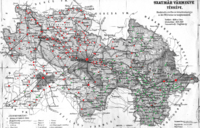
In 1910, county had a population of 396,632 people and was composed of the following linguistic communities:[4]
- Hungarian: 268,385 (67.7%)
- Romanian: 119,760 (30.2%)
- German: 6,670 (1.7%)
- Slovak: 425 (0.0%)
- Ruthenian: 114 (0.0%)
- Croatian: 66 (0.0%)
- Serbian: 27 (0.0%)
- Other or unknown: 1,185 (0.3%)
According to the census of 1910, the county was composed of the following religious communities:[5]
- Greek Catholic: 168,870 (42.6%)
- Calvinist: 126,826 (32.0%)
- Roman Catholic: 67,924 (17.1%)
- Jewish: 29,468 (7.4%)
- Eastern Orthodox: 2,202 (0.6%)
- Lutheran: 1,237 (0.3%)
- Unitarianist: 46 (0.0%)
- Other or unknown: 59 (0.0%)
Subdivisions
In the early 20th century, the subdivisions of Szatmár county were:
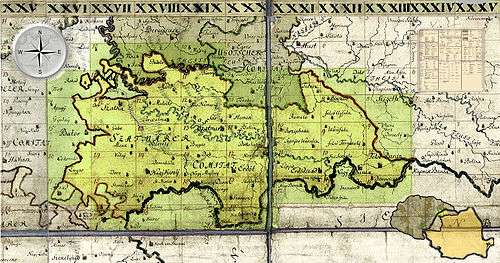
| Districts (járás) | |
|---|---|
| District | Capital |
| Csenger | Csenger |
| Erdőd | Erdőd (now Ardud) |
| Fehérgyarmat | Fehérgyarmat |
| Mátészalka | Mátészalka |
| Nagybánya | Nagybánya (now Baia Mare) |
| Nagykároly | Nagykároly (now Carei) |
| Nagysomkút | Nagysomkút (now Şomcuta Mare) |
| Szatmárnémeti | Szatmárnémeti (now Satu Mare) |
| Szinérváralja | Szinérváralja (now Seini) |
| Urban counties (törvényhatósági jogú város) | |
| Szatmárnémeti (now Satu Mare) | |
| Urban districts (rendezett tanácsú város) | |
| Felsőbánya (now Baia Sprie) | |
| Nagybánya (now Baia Mare) | |
| Nagykároly (now Carei) | |
Csenger, Fehérgyarmat and Mátészalka are now in Hungary; the other towns mentioned are now in Romania.
See also
- Satu Mare County, Romania
References
- "Medzinárodné zmluvy upravujúce hranice ČSR". Users.prf.cuni.cz. Archived from the original on 5 December 2007. Retrieved 27 August 2014.
- "KlimoTheca :: Könyvtár". Kt.lib.pte.hu. Retrieved 6 December 2012.
- "KlimoTheca :: Könyvtár". Kt.lib.pte.hu. Retrieved 6 December 2012.
- "KlimoTheca :: Könyvtár". Kt.lib.pte.hu. Retrieved 19 June 2012.
- "KlimoTheca :: Könyvtár". Kt.lib.pte.hu. Retrieved 19 June 2012.
